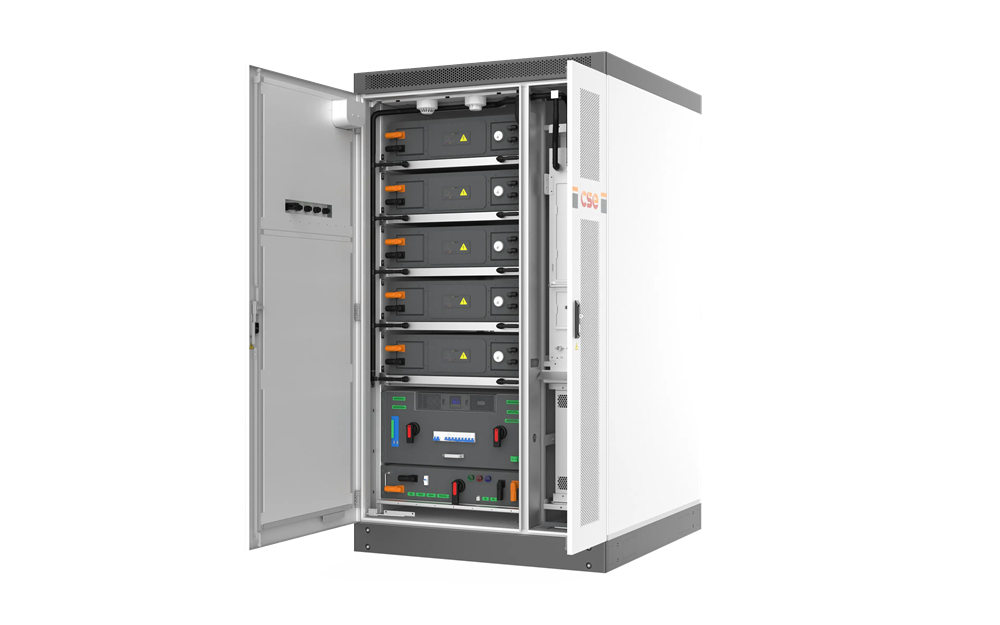
¿Qué es el sistema de almacenamiento de energía todo en uno?
Un sistema de almacenamiento de energía todo en uno es una solución integral e integrada que combina múltiples componentes de almacenamiento y gestión de energía en una sola unidad. A diferencia de las configuraciones tradicionales de almacenamiento de energía, que a menudo requieren sistemas separados para baterías, inversores y software de administración de energía, un sistema todo en uno consolida todo en un solo paquete optimizado.
Estos sistemas suelen ser soluciones preconfiguradas, plug-and-play, lo que los hace fáciles de instalar y operar. Están diseñados para ofrecer almacenamiento, conversión y gestión eficiente de energía para diversas aplicaciones, incluidos proyectos residenciales, comerciales, industriales y de escala de servicios públicos.

1. Módulo de batería
· El núcleo de cualquier sistema de almacenamiento de energía, el módulo de batería, almacena la generación de energía para su uso posterior.
· Los tipos de baterías comunes incluyen baterías de iones de litio, de estado sólido y de flujo, siendo las de iones de litio las más utilizadas para sistemas todo en uno debido a su eficiencia y densidad de energía.
2. Inversor
· Convierte la energía CC (corriente continua) almacenada en energía CA (corriente alterna) para su uso en hogares, negocios o para reintroducirla en la red.
· Muchos sistemas todo en uno cuentan con inversores bidireccionales, lo que permite que la energía entre y salga sin problemas.
3. Sistema de gestión de energía (EMS)
· El cerebro del sistema, un EMS, monitorea y optimiza el uso, el almacenamiento y la distribución de energía.
· Los sistemas avanzados aprovechan la inteligencia artificial y el aprendizaje automático para predecir la demanda de energía y administrar el sistema de manera eficiente.
4. Interfaz de control
· Proporciona una manera fácil de usar para monitorear y controlar el sistema.
· Las interfaces modernas a menudo incluyen aplicaciones móviles o paneles web para obtener información en tiempo real y administración remota.
5. Mecanismos de protección y seguridad
· Incluye características como gestión térmica, protección contra cortocircuitos y extinción de incendios para garantizar que el sistema funcione de forma segura y confiable.
· Con todos los componentes preintegrados, la instalación es significativamente más rápida y sencilla que ensamblar sistemas separados.
· Reduce la necesidad de conocimientos técnicos, haciéndolos accesibles a un público más amplio.
· Los sistemas todo en uno están diseñados para ahorrar espacio, combinando múltiples componentes en una sola y elegante unidad.
· Ideal para ubicaciones con espacio limitado, como viviendas urbanas o edificios comerciales.
· Al integrar componentes, los sistemas todo en uno reducen el costo general de adquisición, instalación y mantenimiento.
· Su naturaleza plug-and-play minimiza los costos de mano de obra y el tiempo de inactividad del sistema.
· La integración de componentes garantiza una comunicación perfecta entre baterías, inversores y EMS, lo que resulta en una mayor eficiencia.
· Los algoritmos avanzados de gestión de energía optimizan el rendimiento y maximizan el ahorro de energía.
· Muchos sistemas todo en uno son modulares, lo que permite una fácil expansión para satisfacer las crecientes necesidades energéticas.
· Adecuado para una amplia gama de aplicaciones, desde pequeñas instalaciones residenciales hasta grandes proyectos industriales.
· Diseñados para funcionar perfectamente con fuentes de energía renovables como paneles solares y turbinas eólicas, los sistemas todo en uno permiten el almacenamiento y la utilización eficiente de energía verde.
· Ayuda a reducir la dependencia de combustibles fósiles y minimizar la huella de carbono.
· Proporciona una fuente confiable de energía durante cortes de energía, lo que garantiza operaciones ininterrumpidas para sistemas críticos.
· Esencial para áreas propensas a desastres naturales o inestabilidad de la red.
· Los sistemas inteligentes de gestión de energía garantizan que la energía se almacene y utilice de manera óptima, minimizando el desperdicio y reduciendo los costos de energía.
· La integración con dispositivos IoT y redes inteligentes mejora aún más la eficiencia.
· Los propietarios de viviendas pueden utilizar sistemas todo en uno para almacenar energía solar, reducir las facturas de electricidad y proporcionar energía de respaldo durante los cortes.
· La integración del hogar inteligente permite la gestión automatizada de la energía basada en patrones de uso.
· Las empresas se benefician del ahorro de costos de energía, la reducción de los cargos por demanda y la mejora de la confiabilidad energética.
· Las industrias pueden utilizar estos sistemas para estabilizar el suministro de energía y respaldar el suministro de energía crítica.
· Las empresas de servicios públicos utilizan sistemas todo en uno para estabilizar la red, gestionar los picos de demanda e integrar fuentes de energía renovables.
· Las aplicaciones a gran escala a menudo requieren sistemas modulares que puedan ampliarse para satisfacer necesidades de alta capacidad.
· Ideal para zonas remotas o rurales sin acceso a una red estable.
· Combinados con paneles solares o turbinas eólicas, estos sistemas pueden proporcionar una solución energética autosostenible.
· Los sistemas todo en uno se utilizan cada vez más en aplicaciones de microrredes, proporcionando soluciones energéticas localizadas que mejoran la resiliencia de la red y reducen la dependencia de plantas de energía centralizadas.
· Los proyectos comunitarios pueden utilizar estos sistemas para compartir recursos energéticos y reducir los costos colectivos.
· Las mejoras en la tecnología de iones de litio, incluida una mayor densidad de energía y características de seguridad, están impulsando la adopción de sistemas todo en uno.
· Las tecnologías emergentes, como las baterías de estado sólido, prometen avances aún mayores en eficiencia y rendimiento.
· Los algoritmos avanzados de gestión de energía permiten un uso más inteligente de la energía y un mantenimiento predictivo.
· Los sistemas impulsados por IA pueden analizar patrones de uso, pronósticos meteorológicos y precios de energía para optimizar el rendimiento.
· Los sistemas modulares todo en uno permiten a los usuarios ampliar su capacidad de almacenamiento de energía a medida que crecen sus necesidades, lo que los convierte en una solución preparada para el futuro.
· Las configuraciones flexibles se adaptan a diversas aplicaciones, desde hogares pequeños hasta grandes instalaciones industriales.
· La integración con dispositivos IoT y redes inteligentes permite una supervisión y gestión de la energía perfectas.
· El control remoto y las actualizaciones en tiempo real brindan a los usuarios una comodidad y control incomparables.
A medida que avanza la tecnología, los sistemas de almacenamiento de energía todo en uno se volverán aún más eficientes, asequibles y versátiles. Las innovaciones en tecnología de baterías, la integración con energías renovables y la gestión energética impulsada por IA impulsarán su adopción en varios sectores. Con el impulso global hacia la sostenibilidad, estos sistemas desempeñarán un papel crucial para lograr la eficiencia energética y reducir la huella de carbono.
En YT Electric, estamos orgullosos de contribuir a la evolución de la tecnología de almacenamiento de energía con nuestro vanguardista sistema de almacenamiento de energía todo en uno 100kW/215kWh – el EcoPower Cube L215. Diseñado para brindar rendimiento, confiabilidad y facilidad de uso, el EcoPower Cube L215 integra tecnología de batería avanzada, un inversor de alta eficiencia y un sistema de administración de energía inteligente en una unidad compacta y escalable.
Ya sea que esté buscando reducir los costos de energía, integrar energía renovable o garantizar una energía de respaldo confiable, el EcoPower Cube L215 ofrece una solución robusta y versátil adaptada a sus necesidades. Obtenga más información sobre cómo puede transformar su estrategia energética aquí.
suscríbase a nosotros para disfrutar de los precios del evento y obtener algunos de los mejores precios.
 compatible con la red ipv6
compatible con la red ipv6

